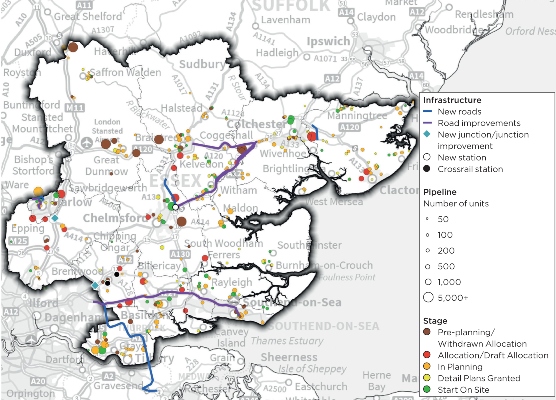Savills have recently published a report about the Essex housing market, outlining how the county could become the future of sustainable housing.
At present, more than 100,000 homes are in the development pipeline across Essex according to research, though this is not enough to meet demand, particularly given the 56% increase in agreed house sales in the county between June 2020 and April 2021, compared with the previous year.
Though, to meet requirements, the new homes must be built in sustainable locations, and align with new road and rail projects to help create the development opportunities and meet housing needs.
Chelmsford, the county town, currently accounts for more than a fifth of the immediate housing pipeline in the county, with more than 4,000 homes under construction at Beaulieu Park and Channels, with 3,000 more set to be developed and 2,500 more in the area after 2036.
A development pipeline of this scale has been made possible by the development of a new railway station at Beaulieu Park and a North East bypass, both of which were financed by a £218 million grant from the Housing Infrastructure Fund (HIF). The A12 is also being widened to help ease congestion in peak travel times whilst accommodating the increased road users from new developments.
New bus, walking and cycling routes will be established by HIF into Harlow town centre in West Essex, and there will be an additional road link over the River Stort as well as improvements made to the A1019, and junction 7a of the M11 under construction, which will enable 6,500 new homes in Harlow and Epping Forest and 10,000 homes in East Hertfordshire.
Further development would also be made possible by the opening of the Lower Thames Crossing and Crossrail at Brentwood and Shenfield in southern Essex, whilst in the north, the HIF will be used to improve the A120 and A133 which will enable 7,500 homes to be built as a new garden community between Colchester and Tendring.
Andy Redman, leader of the development team of Savills in Essex and Suffolk said “There has been phenomenal demand for homes in the last year, North Essex is faring better than the south of the county in terms of building new housing but we are still not doing enough to meet the growing need. There remains a shortage of appropriate sites.
One of the keys to unlocking potential is aligning new housing with appropriate levels of infrastructure. There are sites where this is happening through the HIF but that’s the exception rather than the rule.
Given the restrictions of the green belt – which are mainly in south Essex – local authorities may have to reassess their planning policies if they want to meet demand. That will include identifying new sites that are appropriate for development but also others where development should be curtailed.
Nine local authorities in Essex have declared a climate emergency, with eight setting a target of achieving net-zero carbon by 2030. Yet many of the infrastructure plans within the county are road-based and there is only one new railway station planned at Beaulieu. If local authorities are serious about tackling both the climate and the housing crisis, they must align their housing and infrastructure strategies to maximise both delivery and sustainability. But it’s crucial that land is released in the right places.
Essex already has an existing network of 89 railway stations and building new homes near to these could provide ideal locations for sustainable development. Moreover, there are 3,564 hectares of green belt land within 1km of railway stations that would be appropriate for development. If this was built on at a density of 40 homes per hectare then 142,580 homes could be delivered – enough to meet housing need for around 20 years.
Further funding may be required to ensure there is enough rail capacity to cope with increased passenger numbers, but in general, such development encourages lower levels of private car use and the homes themselves are more attractive because of improved connectivity.
Sustainable development can also be achieved by building close to key amenities to reduce reliance on cars: either by developing near existing urban centres or incorporating those amenities into new schemes. New developments will also need to include sufficient walking and cycling routes.”
Image source- Savills
© Eastern Echo (powered by ukpropertyforums.com).
Sign up to receive your free monthly Eastern Echo newsletter here.










